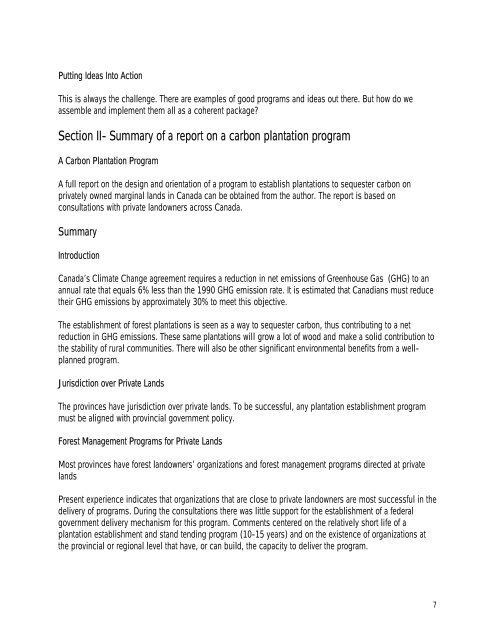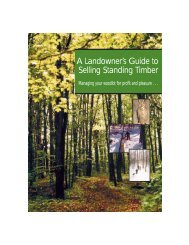Canada's Privately Owned Forest Lands: - Ontario woodlot.com
Canada's Privately Owned Forest Lands: - Ontario woodlot.com
Canada's Privately Owned Forest Lands: - Ontario woodlot.com
- No tags were found...
You also want an ePaper? Increase the reach of your titles
YUMPU automatically turns print PDFs into web optimized ePapers that Google loves.
Putting Ideas Into ActionThis is always the challenge. There are examples of good programs and ideas out there. But how do weassemble and implement them all as a coherent package?Section II- Summary of a report on a carbon plantation programA Carbon Plantation ProgramA full report on the design and orientation of a program to establish plantations to sequester carbon onprivately owned marginal lands in Canada can be obtained from the author. The report is based onconsultations with private landowners across Canada.SummaryIntroductionCanada’s Climate Change agreement requires a reduction in net emissions of Greenhouse Gas (GHG) to anannual rate that equals 6% less than the 1990 GHG emission rate. It is estimated that Canadians must reducetheir GHG emissions by approximately 30% to meet this objective.The establishment of forest plantations is seen as a way to sequester carbon, thus contributing to a netreduction in GHG emissions. These same plantations will grow a lot of wood and make a solid contribution tothe stability of rural <strong>com</strong>munities. There will also be other significant environmental benefits from a wellplannedprogram.Jurisdiction over Private <strong>Lands</strong>The provinces have jurisdiction over private lands. To be successful, any plantation establishment programmust be aligned with provincial government policy.<strong>Forest</strong> Management Programs for Private <strong>Lands</strong>Most provinces have forest landowners’ organizations and forest management programs directed at privatelandsPresent experience indicates that organizations that are close to private landowners are most successful in thedelivery of programs. During the consultations there was little support for the establishment of a federalgovernment delivery mechanism for this program. Comments centered on the relatively short life of aplantation establishment and stand tending program (10-15 years) and on the existence of organizations atthe provincial or regional level that have, or can build, the capacity to deliver the program.7
















